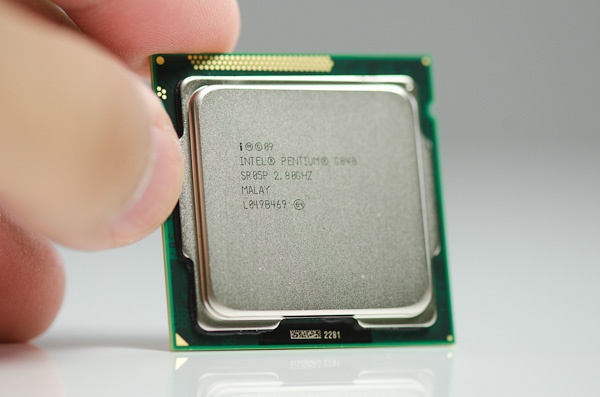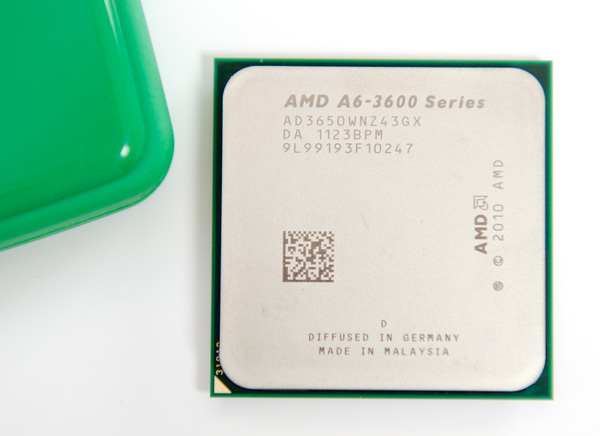The Sandy Bridge Pentium Review: G850, G840, G620 & G620T Tested
by Anand Lal Shimpi on August 23, 2011 12:11 AM ESTFinal Words
Despite boasting Intel's latest Sandy Bridge microarchitecture, the conclusions here are pretty much unchanged from the past. Intel maintains an advantage when it goes up against an AMD chip with the same number of cores, almost regardless of clock speed. In the case of the Pentium G620, even an Athlon II X2 265 with a 27% clock speed advantage can't outperform the Sandy Bridge based CPU. If you're choosing between chips with the same number of cores at the same price, Intel wins.
The decision tilts in AMD's favor if you start comparing to the Athlon II X3. In heavily threaded workloads, the Athlon II X3's third core helps put it ahead of the entire SNB Pentium lineup. If you're building a machine to do offline 3D rendering, multithreaded compiling or video transcoding then AMD continues to deliver the best performance per dollar. It's in the lighter, less threaded workloads that the Pentium pulls ahead. If you're building more of a general use system (email, web browsing, typical office applications and even discrete GPU gaming), the Pentium will likely deliver better performance thanks to its ILP advantages. What AMD has offered these past couple of years is an affordable way to get great multithreaded performance for those applications that need it.
Unfortunately the entire Sandy Bridge Pentium lineup is clock locked. Without turbo modes there's no support for overclocking at all. While these new Pentiums would have normally been great for enthusiasts looking to overclock, Intel has ensured that anyone looking to get more performance for free at the low end will have to shop AMD. Unfortunately Intel's advantage in single/lightly threaded performance is big enough that a clock speed advantage alone is generally not enough to make up for it (see G620 vs. Athlon II X2 265 comparison). It's sad that it has come to this. I was hoping we'd see more K-series SKUs at the low end but it seems like those will only be for the enthusiasts at the high end.
The Pentium's on-die GPU isn't particularly impressive. It's the HD Graphics 2000 from the rest of the Sandy Bridge lineup without Quick Sync or any of the extra video features. I am particularly sad that Quick Sync is missing as it would've made these Pentiums extremely attractive for users that do a lot of video transcoding. Thankfully video decode acceleration and HD audio bitstreaming support remain, so if you're looking to build a cheap Sandy Bridge based HTPC and don't care about the frills these chips will work just fine.
However, if you're building a system to do any sort of 3D gaming you're much better off either springing for a cheap discrete card or looking at AMD's A6-3650 if you want to stay integrated. Although you can play older titles at low resolution on the Pentium's on-board GPU, you'll have a much better experience with a discrete GPU or with the A6.
It all boils down to this. If you want a good, cheap, general purpose PC then the Pentium G620 seems competent and cheap. You can consider the G840 if you want a bit more performance. If you do a lot of threaded work (e.g. offline 3D rendering) the next step up is the Athlon II X3 455. If you do any amount of consumer level video transcoding using apps that are Quick Sync enabled, opt for the Core i3 2100 instead. If gaming is important to you then either buy a discrete GPU or look to AMD's Llano.
As far as AMD's A6 vs. A8 goes, the A8-3850 only commands a $20 price premium over the A6-3650. That $20 gives you another 8 - 10% on the CPU side and around 20% on the GPU. In my opinion, if you're considering a Llano system - spring for the A8.












110 Comments
View All Comments
frozentundra123456 - Tuesday, August 23, 2011 - link
Isnt the clockspeed of the i3 2100 3.1ghz??It is listed in the chart as 2.93 or something like that, less than 3.0 anyway.
zero2dash - Tuesday, August 23, 2011 - link
I'm sorry, I don't know how you can mention SNB Pentium being devoid of HT AND having lower clocks, but then continue on in the same sentence that they're "very similar" to i3.That makes no sense at all. The only way they are "very similar" is if you lower the bclk and turn off HT in the bios and then bench them against each other.
That's like saying a Chevy is just like a Cadillac with cheaper doors, wheels, and less than half of the horsepower and resale value.
erickdingess - Tuesday, August 23, 2011 - link
I'm looking to upgrade and was wondering how the two compare. I don't do a lot of gaming on my PC but I don't want a slower GPU.frozentundra123456 - Tuesday, August 23, 2011 - link
Kind of off topic, but from looking at the graphics card heirarchy on Tom's Hardware, looks like the 9600GT is quite a bit faster, even though it is very old now.Roland00Address - Tuesday, August 23, 2011 - link
It does bring dx11 and lower power consumption though.An A8-3850 is about 75 to 90% the speed of a ati hd5570. They have the same stream processors, but the 5570 has a 8% clock speed advantage. The times that the A8-3850 scores less than 90% of the ati hd5570 is when it is memory starved. There should be no times that the hd5570 should be scoring less than an A8-3850.
The 9600gt is about 10 to 30% faster than a 5570. See here for 5570 vs 9600gt benchmarks.
http://www.anandtech.com/show/2935/5
erickdingess - Wednesday, August 24, 2011 - link
Thank you for the reply.mino - Tuesday, August 23, 2011 - link
That is, until I have noticed the removal of any idle power data ... AMD would not loose terribly on power so those are apparently unanacceptable in Intel PR.Nice AT, keep up the good work!
Paul
Concillian - Tuesday, August 23, 2011 - link
Low end processors were quite interesting when you could squeeze extra performance out of them.Now with locked everything, this stuff is boring.
Intel has succeeded in eeking every dollar out of the low end, but I've spent less money on my computer this year than perhaps any yearr in the last decade as a result. Just so 'bleh' out there unless you're spending $400 on mobo + CPU, which is something I haven't done since the 386/486 days.
I need a new hobby
=(
ikeke1 - Wednesday, August 24, 2011 - link
I was about to build a basic web box for my GF sister, almost about to go for i3-2100 - but at the last minute spotted the G620. So few minutes later i had ordered:Msi ITX H61I-E35 motherboard
G620
2x2GB 1333Mhz ddr3
and a cheap ITX case
All in all ~€150.
Scavanged a 2,5" HDD from GFs dead laptop, had a spare DVD writer and Win7 HP x64 licence. Now shes got a SILENT and classy box :) The UPS is showing ~50W consumption with the crappy 300W PSU i have feeding it - so most likely with a brick-psu or efficient one it`ll draw 35-40`ish.
The sister is most pleased - she was going to buy a last gen mac mini :D
superccs - Wednesday, August 24, 2011 - link
This is clearly Intels attempt to dip into AMDs low end turf. Just like AMD attempted to counter the SB with the X6 line up. They are both only attempts.